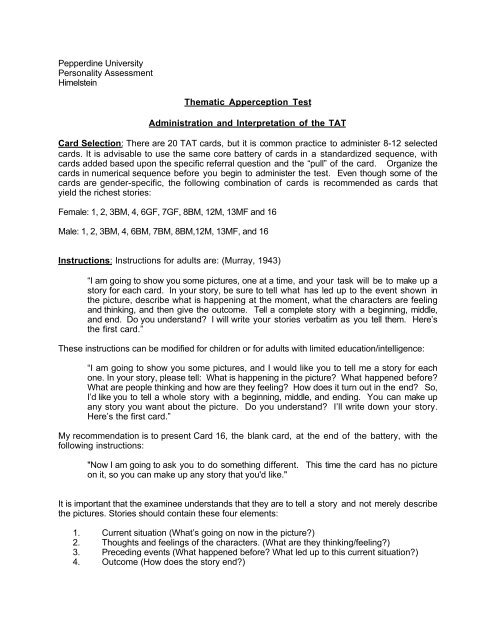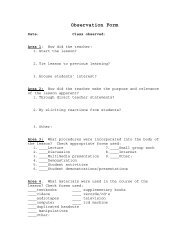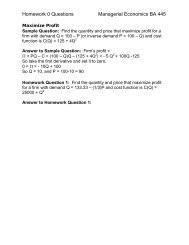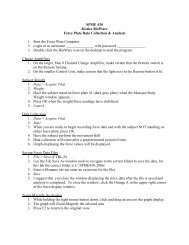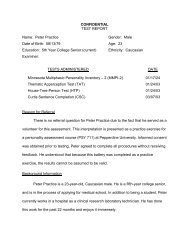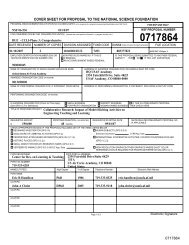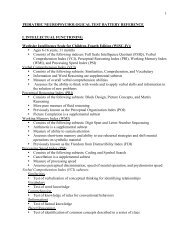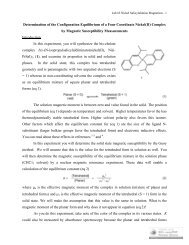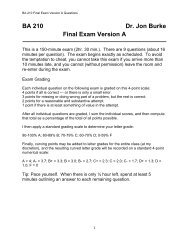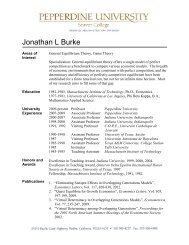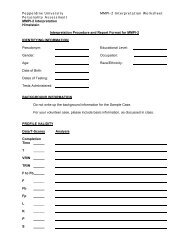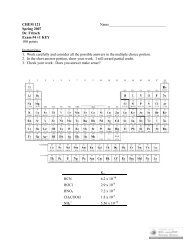Thematic Apperception Test Administration and Interpretation
Thematic Apperception Test Administration and Interpretation
Thematic Apperception Test Administration and Interpretation
You also want an ePaper? Increase the reach of your titles
YUMPU automatically turns print PDFs into web optimized ePapers that Google loves.
Pepperdine University<br />
Personality Assessment<br />
Himelstein<br />
<strong>Thematic</strong> <strong>Apperception</strong> <strong>Test</strong><br />
<strong>Administration</strong> <strong>and</strong> <strong>Interpretation</strong> of the TAT<br />
Card Selection: There are 20 TAT cards, but it is common practice to administer 8-12 selected<br />
cards. It is advisable to use the same core battery of cards in a st<strong>and</strong>ardized sequence, with<br />
cards added based upon the specific referral question <strong>and</strong> the “pull” of the card. Organize the<br />
cards in numerical sequence before you begin to administer the test. Even though some of the<br />
cards are gender-specific, the following combination of cards is recommended as cards that<br />
yield the richest stories:<br />
Female: 1, 2, 3BM, 4, 6GF, 7GF, 8BM, 12M, 13MF <strong>and</strong> 16<br />
Male: 1, 2, 3BM, 4, 6BM, 7BM, 8BM,12M, 13MF, <strong>and</strong> 16<br />
Instructions: Instructions for adults are: (Murray, 1943)<br />
“I am going to show you some pictures, one at a time, <strong>and</strong> your task will be to make up a<br />
story for each card. In your story, be sure to tell what has led up to the event shown in<br />
the picture, describe what is happening at the moment, what the characters are feeling<br />
<strong>and</strong> thinking, <strong>and</strong> then give the outcome. Tell a complete story with a beginning, middle,<br />
<strong>and</strong> end. Do you underst<strong>and</strong> I will write your stories verbatim as you tell them. Here’s<br />
the first card.”<br />
These instructions can be modified for children or for adults with limited education/intelligence:<br />
“I am going to show you some pictures, <strong>and</strong> I would like you to tell me a story for each<br />
one. In your story, please tell: What is happening in the picture What happened before<br />
What are people thinking <strong>and</strong> how are they feeling How does it turn out in the end So,<br />
I’d like you to tell a whole story with a beginning, middle, <strong>and</strong> ending. You can make up<br />
any story you want about the picture. Do you underst<strong>and</strong> I’ll write down your story.<br />
Here’s the first card.”<br />
My recommendation is to present Card 16, the blank card, at the end of the battery, with the<br />
following instructions:<br />
"Now I am going to ask you to do something different. This time the card has no picture<br />
on it, so you can make up any story that you'd like."<br />
It is important that the examinee underst<strong>and</strong>s that they are to tell a story <strong>and</strong> not merely describe<br />
the pictures. Stories should contain these four elements:<br />
1. Current situation (What’s going on now in the picture)<br />
2. Thoughts <strong>and</strong> feelings of the characters. (What are they thinking/feeling)<br />
3. Preceding events (What happened before What led up to this current situation)<br />
4. Outcome (How does the story end)
TAT <strong>Interpretation</strong><br />
Himelstein<br />
Page 2<br />
Prompting is allowed if story elements are omitted, but prompt each of the story elements only<br />
once per story. Do not ask specific leading questions. It is better to phrase the prompting<br />
questions as noted above.<br />
Administer each card individually <strong>and</strong> have the examinee tell each story out loud. The test<br />
administration can be tape-recorded, with the consent of the examinee, but it is good practice to<br />
write down their responses verbatim as well.<br />
<strong>Interpretation</strong>: There are no formal, normative st<strong>and</strong>ards for the TAT. The simplest procedure<br />
for studying TAT responses is the inspection technique. Most clinicians interpret the TAT stories<br />
informally; repetitive patterns or themes become apparent by reading through a subject's stories.<br />
It is useful to know the typical themes <strong>and</strong> stories that are elicited by each of the cards.<br />
Deviations from these may offer rich interpretive value. Typical themes are presented in Groth-<br />
Marnat (2003) Chapter 10, in Bellak (1997) Chapter 4, <strong>and</strong> in Teglasi, (2001). It is important to<br />
look for corroboration of patterns in other stories, other test results, or in background<br />
information. Bellak (1997) says "A repetitive pattern is the best assurance that one does not<br />
deal with an artifact".<br />
One main thing to consider in the interpretation of the TAT is that the pictures are best seen<br />
psychologically as a series of social situations <strong>and</strong> interpersonal relations. Another way to<br />
consider them is that all characters in the stories are projected aspects of the self, keeping in<br />
mind that they may represent the ideal self, the real self, the feared self, etc.<br />
Things to look for in card responses:<br />
1. Following the task directions<br />
2. Card pull: Manifest content (Descriptive)<br />
Latent content (Interpretive)<br />
3. Initial reactions to cards <strong>and</strong> to themes presented: Card 1 may provide key issues; also<br />
note initial reaction to each card<br />
4. Personality Conflicts: Interpersonal, Intrapersonal<br />
5. Themes, plots introduced<br />
6. Characters<br />
7. Supportive figures – who is brought in to story<br />
8. Affect<br />
9. Action<br />
10. Final outcome or resolution<br />
11. Intercard relationship<br />
12. Ego functions - defenses<br />
13. Language usage<br />
14. Identification issues:<br />
Usually identify with same gender; if not, may indicate gender identity issues or<br />
may indicate vulnerability <strong>and</strong> need to project onto gender different person in<br />
order to distance the issue from self<br />
15. Indicators for therapeutic progress <strong>and</strong> outcome<br />
16. Personality structural analysis: id, ego, superego<br />
17. Psycho-sexual development stage: oral, anal, phallic, latency, genital


